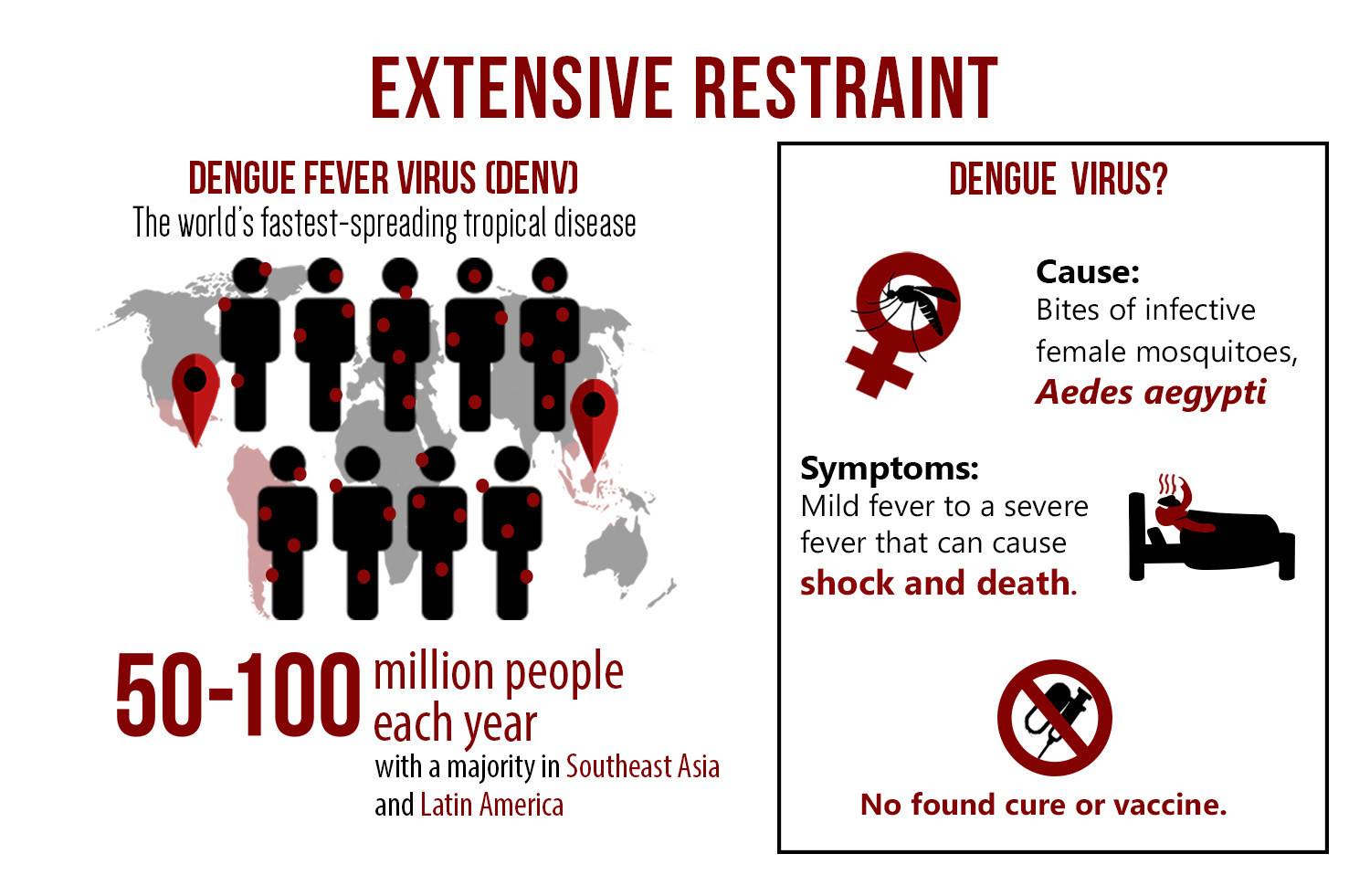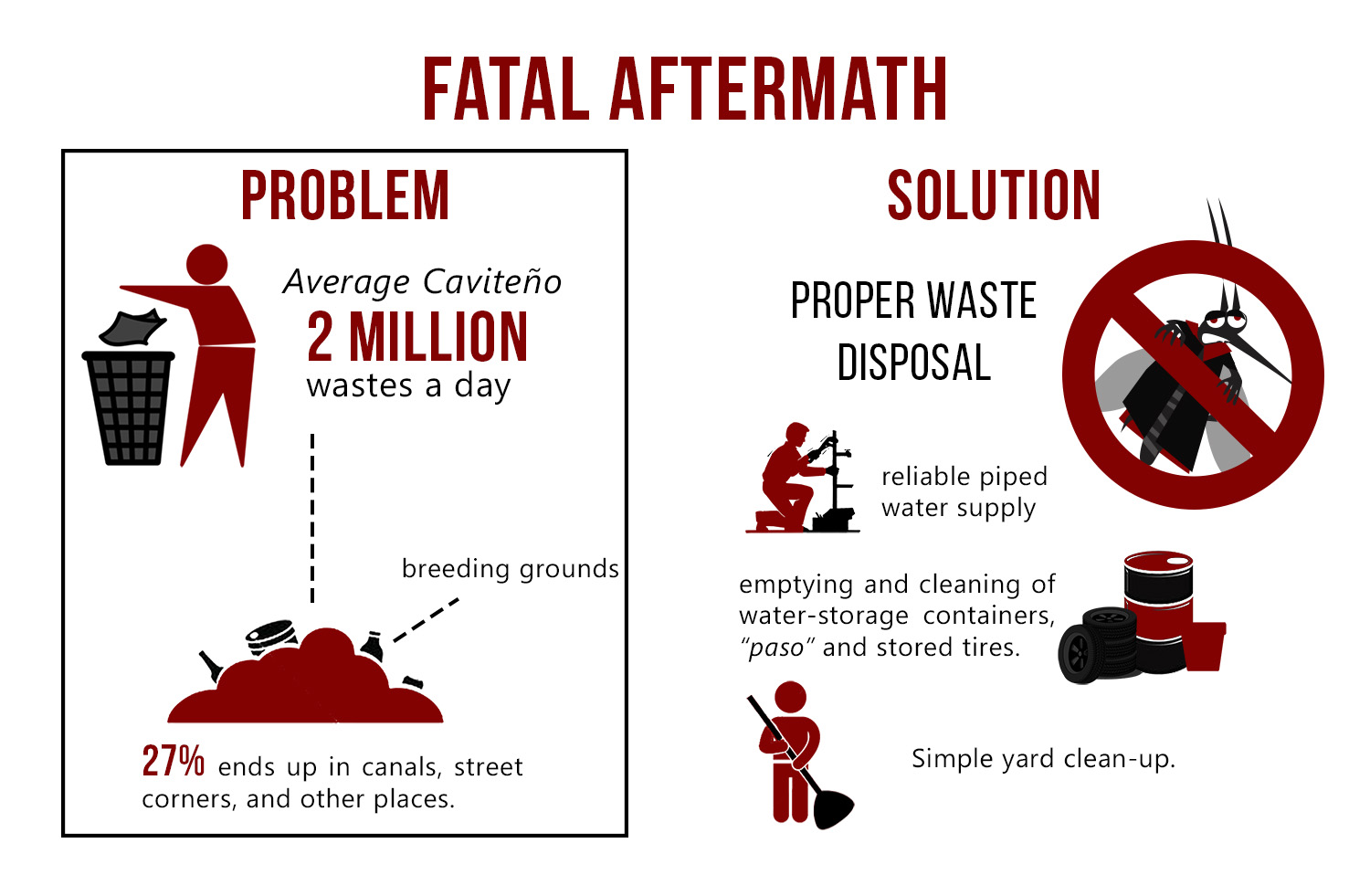Scrounger’s land
 Infographic by Mikhaela Torres
Infographic by Mikhaela Torres
If there’s one peculiar thing that has irked the Filipinos for generations, it would probably be flying pests, particularly mosquitoes. Hot, humid, and rainy—our country’s climate is a wonderland for these little buggers. The Philippines might have been too good of a sanctuary that they’ve long been infecting the country with their mischievous bites—until now.
Far beyond the state of calamity Cavite was under earlier this year due to the dengue fever outbreak, other regions such as Region 3, Region 1, and Region 10 was also crippled by the catastrophic event. Now the Philippines is in dire need of a stronger and developed force against dengue-carrying mosquitoes.
Finding out a friend’s hospitalized unconsciously can make one think dengue is the culprit. Dengue fever, the world’s fastest-spreading tropical disease is transmitted to humans through the infective bites of female mosquitoes Aedes aegypti and Aedes albopictus says the World Health Organization (WHO). Apart from the mild fever, dengue-stricken people can also develop hemorrhagic fever or severe dengue that can cause shock and death. This chilling reality adds to the fact that even today, medical experts haven’t formulated a vaccine or any kind of cure for dengue.
Aware of dengue’s obnoxious popularity in the Philippines with near 100,000 dengue cases in 2015, the Department of Health (DOH) intensifies their anti-dengue campaign as the year ends, highlighting an anti-dengue strategy called the “4S strategy against dengue.” This campaign advices people to Search and destroy possible breeding places of dengue-causing mosquitoes like flower pots, bottles, old tires, cans, roof gutters, water drums, and other containers that might hold stagnant water; apply Self–protection measures including wearing long sleeves or long pants to avoid frequent mosquito bites; Seeking early consultation concerning early signs and symptoms of dengue like sudden high fever, severe headaches, severe joint and muscle pain, vomiting and the like; and Saying no to indiscriminate fogging or widespread mosquito killing fog as it can only kill the adult infected mosquito and miss out the larvae or kiti–kiti.
While inexistence of the dengue cure and vaccine leaves us in high potential of acquiring the dengue virus, the US’ National Pest Management Association (NPMA) suggests the easiest defense that always comes in handy: bug repellents. The Centers for Disease Control and Prevention in the US advise people to use products that have a label for DEET or diethyltoluamide, picaridin, and para–methane–diol that comes in lotion, spray and many other forms available in the country that all are proven effective.
As hard as we try to eradicate these pests—with the unsightly effects of typhoons and the dengue havoc aside—mosquitoes always seem to find their way back. As some vampires find certain prey more alluring than others, mosquitoes also have a list of standards for a tasty food choice. They select their chows based on individual factors or physical factors like fitness level, size, and blood type among others.
One study done by researchers at the Institute of Pest Control Technology in Japan found that mosquitoes tend to land twice as much on people with type O blood than others in an inhibited area because of a chemical humans secrete through their skin that attracts more mosquitoes.
Another fine ingredient to a mosquito’s palate is the carbon dioxide that comes from our breath. Mosquitoes use their maxillary palp or their odor sensor to detect carbon dioxide as far as 164 feet away to locate their targets, says Dr. Jonathan Day, a medical entomologist and mosquito expert at the University of Florida, US. Therefore, people who exhale more gas—such as the pregnant and overweight—are more likely to get bitten by these prickly parasites.
Apart from carbon dioxide detection, mosquitoes can identify their prey at a close range by sensing lactic acid, uric acid, and other substances that are expelled through a person’s sweat. The educational US-based Smithsonian Magazine reported that since working out can increase the production of lactic acid and heat in a person’s body, it likely makes gym junkies more attractive to mosquitoes. Mosquitoes also tend to be more fascinated to victims dressed in dark colors as it helps people produce more heat that makes them more visible under a mosquito’s radar.
Although the findings propose certain criteria for a mosquito’s treat, people shouldn’t be too blithe with these buggers; for as long as your heart is pumping blood, you are still a potential target.
Despite the seemingly simple ways to prevent mosquito bites like cheap repellents and old-school mosquito sprays, the best way to stop the epidemic in the community may be the hardest to achieve—proper waste disposal. In point of fact, a person produces approximately half a kilogram of waste a day. With an estimated population of four million in Cavite alone, an average Caviteño throws up to two million wastes a day. Although garbage trucks are on the round, a minimum of 27 percent of our daily waste still ends up in canals, street corners, and other places, which can be the ideal breeding grounds of mosquitoes according to the Department of Environment and Natural Resources (DENR).
Since mosquitoes are often linked to insufficient sanitation and waste disposal services, WHO suggested a change in human habit like installing screens on windows and doors. They also recommended environmental modification, which involves the installation of a reliable piped water supply to communities that depend on the traditional “poso,” or the manual water pump for water supply.
In addition, WHO strongly recommends an environmental manipulation that advocates a frequent emptying and cleaning of water-storage containers, “paso” or garden pots, cleaning of gutters, and covering stored tires from rainfall. Apparently, the easiest way for mosquito breeding control seems to be the locals’ most neglected act.
An action for an epic change in waste management can be a bit dramatic and demanding, but a simple yard clean-up can be a good change starter.
These little dengue-carrying bloodsuckers won’t go away as far as metamorphosis is concerned. But at the end of the day, being jaded and throwing these imperative cautions in the winds isn’t an option for us, because these mini vampires definitely won’t make us immortal.
Sources:
www.cnnphilippines.com
www.abs-cbnnews.com
www.denguevirusnet.com
www.mayoclinic.org
www.dailymail.co.uk
www.medicaldaily.com
www.time.com
www.breakdengue.org
www.mb.com
www.reuters.com








